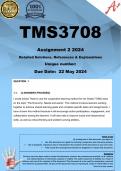TMS3708
Assignment 2 2024
Detailed Solutions, References & Explanations
Unique number:
Due Date: 22 May 2024
QUESTION 1
1.1. (2 ANSWERS PROVIDED)
I would advise Thato to use the cooperative learning method for her Grade 7 EMS class
on the topic "The Economy: Needs and wants." This method involves learners working
together to achieve shared learning goals and complete specific tasks and assignments. I
have chosen this method because it will encourage active participation, engagement, and
collaboration among the learners. It will also help to improve social and interpersonal
skills, as well as critical thinking and problem-solving abilities..
Terms of use
By making use of this document you agree to:
• Use this document as a guide for learning, comparison and reference purpose,
• Not to duplicate, reproduce and/or misrepresent the contents of this document as your own work,
• Fully accept the consequences should you plagiarise or misuse this document.
Disclaimer
Extreme care has been used to create this document, however the contents are provided “as is” without
any representations or warranties, express or implied. The author assumes no liability as a result of
reliance and use of the contents of this document. This document is to be used for comparison, research
and reference purposes ONLY. No part of this document may be reproduced, resold or transmitted in any
form or by any means.
,QUESTION 1
1.1. (2 ANSWERS PROVIDED)
I would advise Thato to use the cooperative learning method for her Grade 7 EMS
class on the topic "The Economy: Needs and wants." This method involves learners
working together to achieve shared learning goals and complete specific tasks and
assignments. I have chosen this method because it will encourage active participation,
engagement, and collaboration among the learners. It will also help to improve social
and interpersonal skills, as well as critical thinking and problem-solving abilities. The
collaborative nature of this method will create a positive interdependence among the
learners, where each student's success is linked to the success of the group as a
whole. This will help to foster a sense of teamwork and shared responsibility, which
can increase learner interest and motivation in the classroom. Additionally, cooperative
learning allows learners to connect emotionally and intellectually with the subject
matter, making it a suitable method to improve learner interest and participation in the
Grade 7 EMS classroom.
OR
I would advise Thato to use the cooperative learning method for her Grade 7 EMS
class on the topic of "The Economy: Needs and wants". Cooperative learning will be
suitable because it can encourage active participation and engagement among the
learners. This method will allow the learners to work together in small groups, which
can help build social skills and create a positive learning environment. Additionally,
cooperative learning can encourage critical thinking and problem-solving skills, which
are important for understanding the concepts related to the economy.
In the context of Thato's classroom, where learner interest and participation seem to
be low, cooperative learning can help create a more interactive and engaging learning
experience. It can also help Thato create a more learner-centered approach, allowing
the learners to take responsibility for their own learning and work together to achieve
shared learning goals. By working in groups, the learners can share their ideas, learn
from each other, and develop a deeper understanding of the topic.
Disclaimer
Extreme care has been used to create this document, however the contents are provided “as is” without
any representations or warranties, express or implied. The author assumes no liability as a result of
reliance and use of the contents of this document. This document is to be used for comparison, research
and reference purposes ONLY. No part of this document may be reproduced, resold or transmitted in any
form or by any means.
, Overall, the cooperative learning method can address the issues of learner disinterest
and lack of participation by promoting a more collaborative and interactive learning
environment, which is crucial for the Grade 7 EMS class on the topic of the economy.
1.2. (2 ANSWERS PROVIDED)
Using the cooperative learning method for the Grade 7 lesson on the topic "The
Economy: Needs and Wants" can significantly improve learner interest and
participation in Thato's EMS classroom. The use of cooperative learning will allow
learners to actively engage with the content, work collaboratively, and take
responsibility for their own learning. This method aligns with the goals of the lesson
and provides a learner-centered approach that fosters critical thinking,
communication, and interpersonal skills.
To practically deliver the lesson using the cooperative learning method, Thato can
follow these steps:
1. Formation of Groups: Thato can divide the class into small groups, ensuring
that each group is diverse and comprises students with varying abilities,
strengths, and backgrounds. This will promote positive interdependence and
individual accountability within the groups.
2. Explanation of the Activity: Thato will explain the cooperative learning activity to
the students, providing clear instructions on the topic, learning objectives, and
the task they will be working on.
3. Preparation: Students will have time to prepare for their roles within their
groups. They may be provided with resources, such as readings, case studies,
or research material related to the topic.
4. Implementation: The students will engage in the cooperative learning activity
by working together within their groups. They can discuss the needs and wants
in an economy, share their ideas, and collaboratively come up with examples
and solutions.
Disclaimer
Extreme care has been used to create this document, however the contents are provided “as is” without
any representations or warranties, express or implied. The author assumes no liability as a result of
reliance and use of the contents of this document. This document is to be used for comparison, research
and reference purposes ONLY. No part of this document may be reproduced, resold or transmitted in any
form or by any means.




